Objective
- Registration
- Knowledge base (e.g., proper execution of weightlifting exercises)
- Workout planner
- Progress tracking over time
- Daily workout notes, suggestions, and warnings
- Achievements for reaching milestones
Research
Desk research
| Mapped out applications | Key features | What did we like? | What didn't we like? |
|---|---|---|---|
| Garmin | Sleep quality analysis, stress level tracking, recording workout data with progress statistics, personalized workout plans based on fitness levels, option to create custom workout plans, challenges and fitness milestones, calendar for tracking consistency, community building features, blog for fitness tips and articles, workout video library, active status notification to a contact person during workouts. | Provides a lot of data, intuitive, fast-to-learn interface, motivating. | Sometimes I couldn't remember where to find things. |
| Polar | Sleep quality measurement, calendar – tracking consistency, blog, storing workout data with daily/weekly/monthly averages. | I can start a workout without associating/using any devices. | Until sufficient data is gathered, only the blog and workout start features are available. I find my options limited. |
| FitOn | Video workouts, meditations, articles on healthy living, recipes, groups | High-quality videos available in the free plan. Focuses on mental health preservation as well, not just physical health | Aggressive monetization with non-skippable videos. Recipes are not available in the basic plan |
| Blogilates | Video workouts, community building, calendar-based progress tracking, challenges, programs | Easy-to-navigate, intuitive interface. No immediate registration required to browse the app. No ads in the basic version. | The placement of premium content disrupts navigation, often blending with the basic content. |
| Fitify | Personalized workout plans; Helpful animations for each exercise; Recipe recommendations for workouts. | Personalized workout plans. Gamification. | Extremely long questionnaire at the beginning. (Of course, without this, there wouldn't be a personalized workout plan.) |
| 30 days fitness challenge | Full workouts, vegetarian-friendly meal plans. Workouts are preceded by a self-assessment test. | Workouts are supported by animations. Meal plans, shopping lists, and full workout programs are available in the basic app. | Aggressive registration pressure, many basic functions are difficult to use because of it. Unmuted, unskippable ads, even during workouts. |
| Hevy | Statistics, custom workout plan | Customization options; Helpful videos | No personalized workout plans; Lacks gamification elements to enhance motivation. |
| Strava | Recording/browsing/recommending workout routes based on location, Challenges, performance sharing, groups, Tracking personal workouts. | Limited functionality but executes it well (workout route recording and sharing), Clear menu system, easy to navigate. | It's more useful when we want to measure and visualize an existing habit. |
Hypotheses
- People use smart devices because they are interested in the statistics.
- They would prefer an app that provides personalized workout plans and tutorials.
- Using the app helps in maintaining a regular exercise routine.
- Tracking progress with data can motivate regular physical activity.
- People enjoy working out in a social setting.
User research interview questions
- Do you exercise? If yes, how long have you been doing it and what type of exercise? How often?
- Do you use any apps to track your sports performance? If yes, which one and why did you choose it? What has been your experience with it? If not, what would be important for you in such an app?
- What would motivate you to exercise regularly?
- Do you enjoy working out with others? If yes, why?
- Do you use a smart device to track your workouts? If yes, what data are you interested in? Why are these data important to you? If not, do you track your workout data manually? (Could you elaborate on that, please?)
- How important is it for you to follow a personalized workout plan to track your progress?
- What do you think about an initial assessment that would provide you with a personalized workout plan before using the app? If you are positive about it, how much time would you dedicate to an assessment questionnaire?
- Is there anything else you would like to share with us?
Key findings
As we listened to our users’ stories, a clear picture began to emerge. While many people are committed to regular exercise, they don’t actively seek out fitness-specific apps. Instead, they rely on built-in health trackers like Apple Health, Google Fit, or Huawei Health to monitor their activity.
When it comes to tracking, simplicity is key—most users use their smartphones or smartwatches but don’t invest in more specialized devices like heart rate monitors. Their workouts are diverse, ranging from running and TRX to kettlebell exercises and aerobics, yet they largely prefer to exercise alone.
A typical routine consists of about three workouts per week, driven by a mix of motivations. For some, it’s about maintaining physical health or building strength, while for others, it’s a way to unwind, manage stress, and create a structured weekly habit. These insights provided us with a deeper understanding of what truly matters to our users, shaping the direction of our design decisions.
Behavioral variables
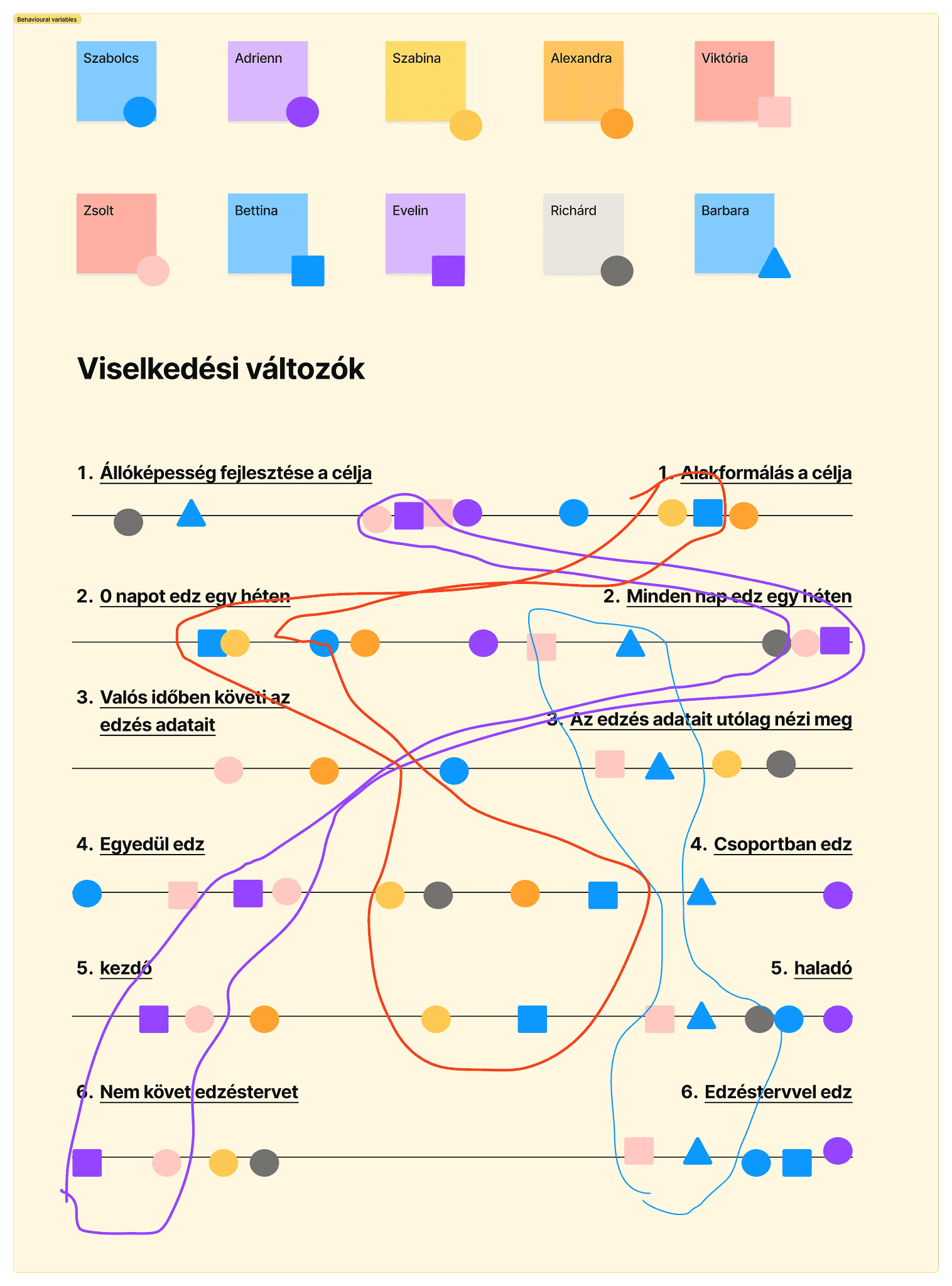
User personas
37 years old, lives in Budapest, and works as a successful sales representative. Her job involves making calls with potential clients and closing deals, requiring her to spend a lot of time with customers. She feels that her sedentary work negatively impacts her endurance, so she has decided to work out regularly. Due to her unpredictable schedule, she chooses her workout type based on her available free time and mood.
- She wants to start a more active lifestyle
- Sports provide a great way for her to relieve stress.
- She needs fresh air and sunlight.
- She is afraid of developing health issues, so she wants to be mindful of her workouts.
- She works with many people throughout the day, so she prefers to work out alone.
- She finds it difficult to decide on a type of exercise on her own.
- She wants to work out 4-5 times a week.
- She finds it easier to experience the freedom that exercise brings when working out alone.
26 years old, lives in Győr, and works as a project manager. He is single and lives alone. His job allows for flexible working hours, so he manages to work out 4-5 times a week. Sports have been an integral part of his life since childhood. He usually trains alone but occasionally works out with friends.
- He is curious about the limits of her physical capabilities.
- Sports recharge him, giving him new energy for afternoon meetings.
- He has difficulty creating his workout plan on his own.
- He struggles to find a method to track his personalized workouts.
- He creates his workout plans with the help of an expert.
- He performs focused workouts that last at least 1 hour.
- He records the workout data after completing the exercises or workout sessions, not in real-time.
- He uses smart devices to track his heart rate and calories burned.
34-year-old IT administrator living in Solymár with his family. Three years ago, he became a father to twin daughters and took parental leave to care for them. He has never been slim, but since the birth of his children, he has gained a significant amount of weight, now weighing over 130 kg—the most he has ever weighed. As his daughters have grown a bit and his weight has started to bother him, he has decided to start working out. Since the grandparents live far away, he relies on his wife’s support—she works from home once a week and can take care of the children. This allows József to work out 1-2 times a week, attending fitness training with a friend.
- He feels that he is overweight and wants to improve it.
- He wants to see his daughters grow up.
- He requires personal attention.
- He has difficulty motivating himself alone.
- He fears that health issues may arise in the future due to his overweight.
- He doesn't manage to work out as often as he would like.
- Due to constant staying at home, he easily gains weight.
- Because of his children, his eating habits are irregular as they are often awake at night.
- Physical activity was not an integral part of his family life.
Journey map

Ideation
How might we?
- How could we make the time spent on training more enjoyable?
- How could we convey the importance of stretching in a way that it doesn't feel like a burden or a must-do task?
Story board
Background information, context: Rebeka trains 4-5 times a week. She has no prior experience in sports, so it is challenging for her to create her own workout routine. Her goal is to relieve everyday stress, refresh both physically and mentally, and stay fit.
- Tension relief
- Healthy lifestyle
- Maintain fitness
- Motivation
- Guidance / personal trainer
- Decision-making freedom based on mood
- Assistance in selecting the right workout
- Support along the "journey"
- Feels better physically and mentally
- Improves or at least maintains her fitness level
- Her schedule is hectic
- Weak body awareness
- Feels anxious while exercising
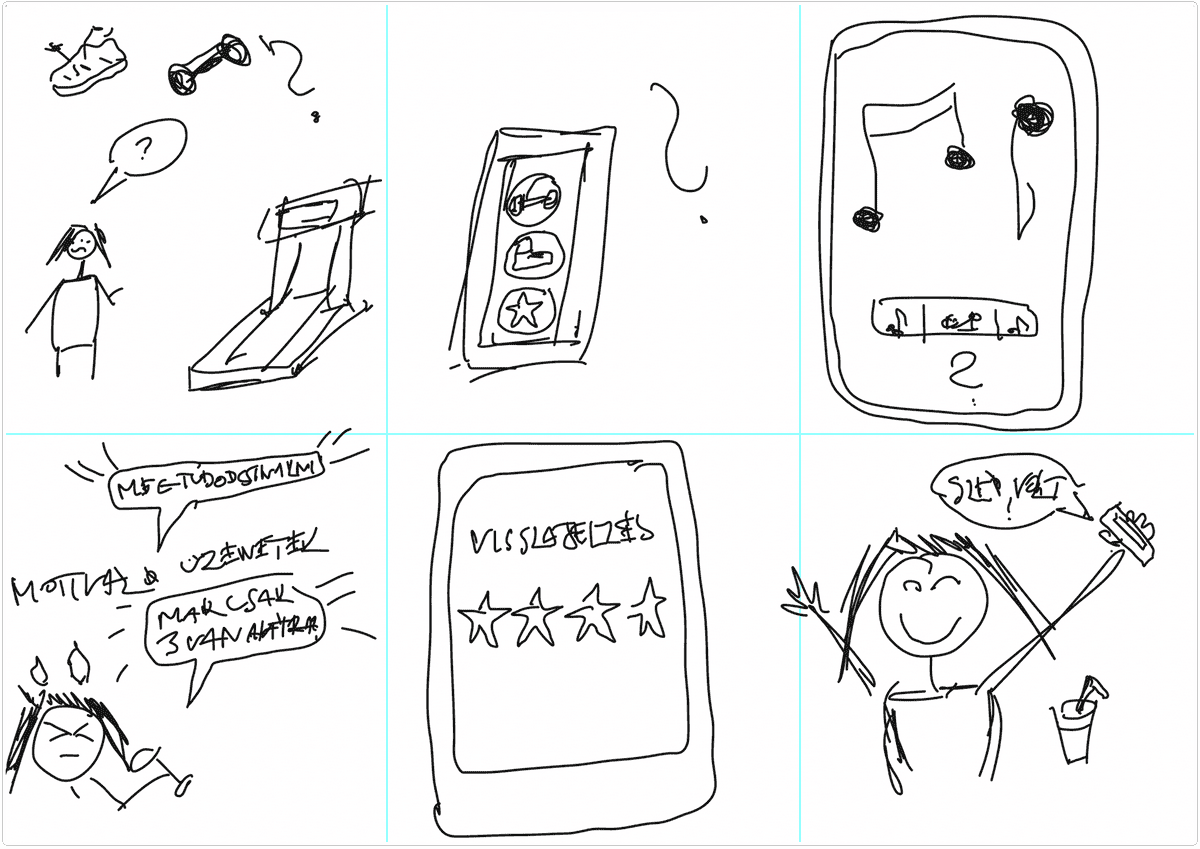
User flow
The user flow was designed to guide Rebeka through a smooth and intuitive workout experience, starting from finding the right workout to reviewing it after completion. Here’s how the flow looks:
-
Start
Rebeka opens the app and logs in, greeted with a personalized dashboard. -
Find a Workout
She selects her workout based on her current mood or preference (e.g., stress relief, fitness maintenance). The app suggests workouts tailored to her goals and experience level. -
Workout Execution
Rebeka begins her workout, with real-time guidance and assistance from the app, including form tips or pacing reminders as needed. -
Workout Completion
After completing the workout, the app automatically syncs her data (duration, calories burned, etc.) from her smart device or phone. -
Statistics Displayed
The app displays detailed statistics, including progress over time and performance metrics, giving Rebeka insight into her workout results. -
Review
Rebeka is prompted to rate her workout on a scale of 1-5 stars, providing feedback on the session and the app’s experience. -
End
Once she finishes reviewing, the app provides motivational feedback and suggests the next workout, closing the loop until her next session.
This user flow ensures that Rebeka can easily navigate the app, track her progress, and stay engaged with personalized feedback that keeps her motivated.

Design
Low fidelity prototype
We started with simple wireframes that represented three core screens for Rebeka’s experience:
Personalized Home Page
The home page was designed to give Rebeka quick access to personalized workout recommendations, tracking
her progress, and motivational elements. This page aimed to immediately engage her based on her goals and
preferences.
Workout List Page
The workout list allowed Rebeka to browse and filter workouts based on her current mood, fitness level,
and goals. The filters were simplified to make it easy for her to find the most relevant workouts.
Workout Progress Page
This page tracked Rebeka’s real-time progress during a workout, displaying metrics such as time, calories
burned, and heart rate. After completion, it showed her detailed statistics to reflect her performance and
improvement.
These low-fidelity wireframes helped us focus on the app's essential functionality and user flow, ensuring everything felt intuitive and streamlined for Rebeka.

Mid fidelity prototype
Building on the wireframes, we created a mid-fidelity prototype with more defined UI elements and interactions, allowing us to further test and refine the design. These included interactive elements like buttons, progress bars, and basic color schemes, helping us assess the app’s usability and overall experience.
You can check out the mid-fidelity prototypes with more defined UI elements and interactions in Figma by clicking the button below. This will give you a closer look at the interactive elements like buttons, progress bars, and basic color schemes that helped us refine the app’s usability and overall experience.
Testing
Usability test key findings

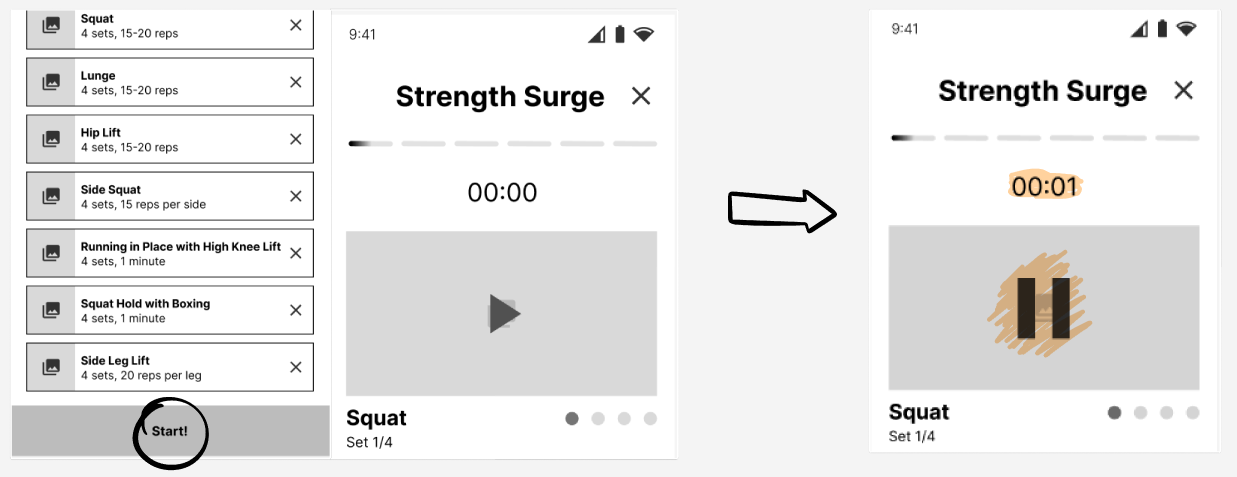
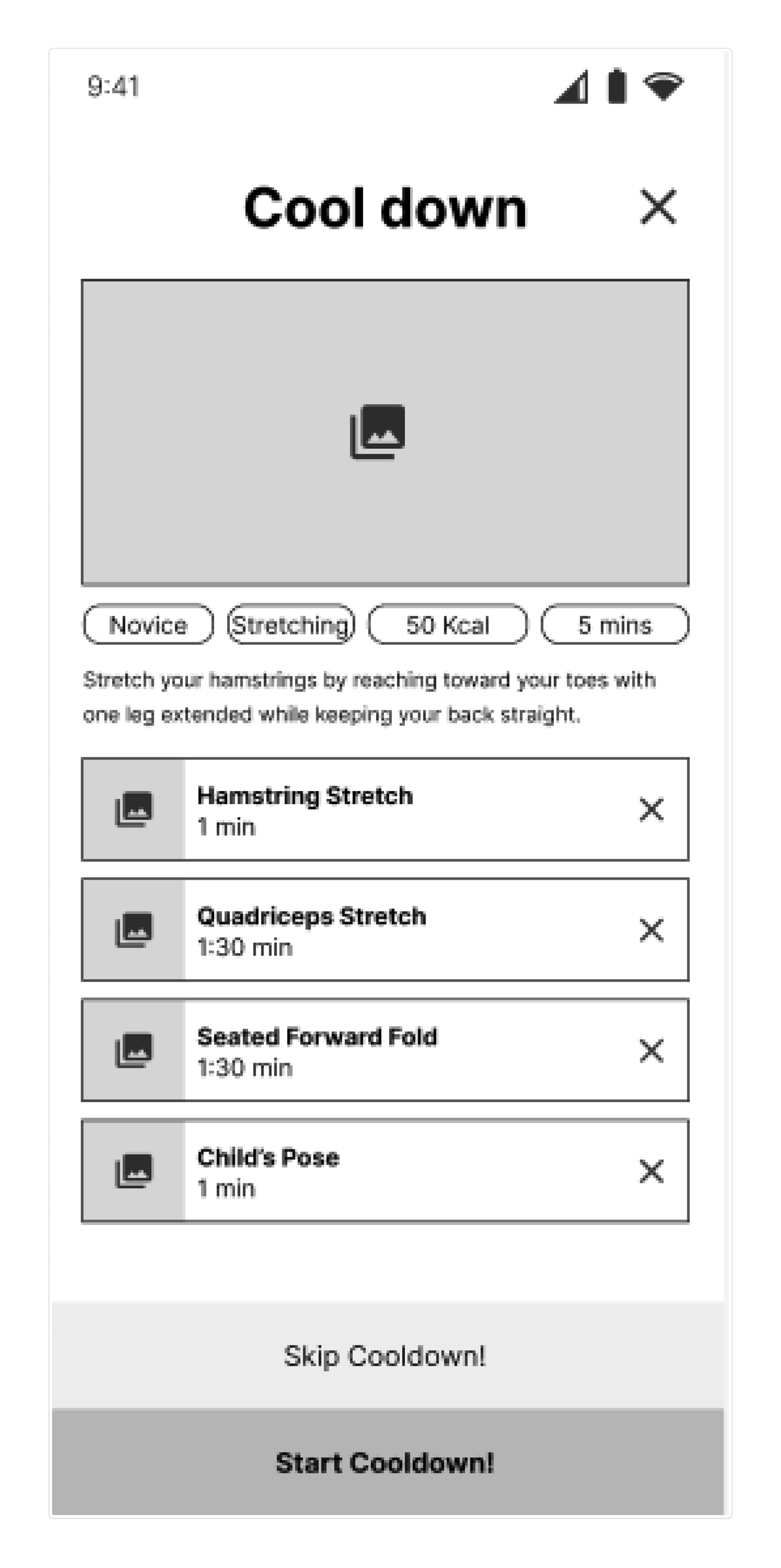
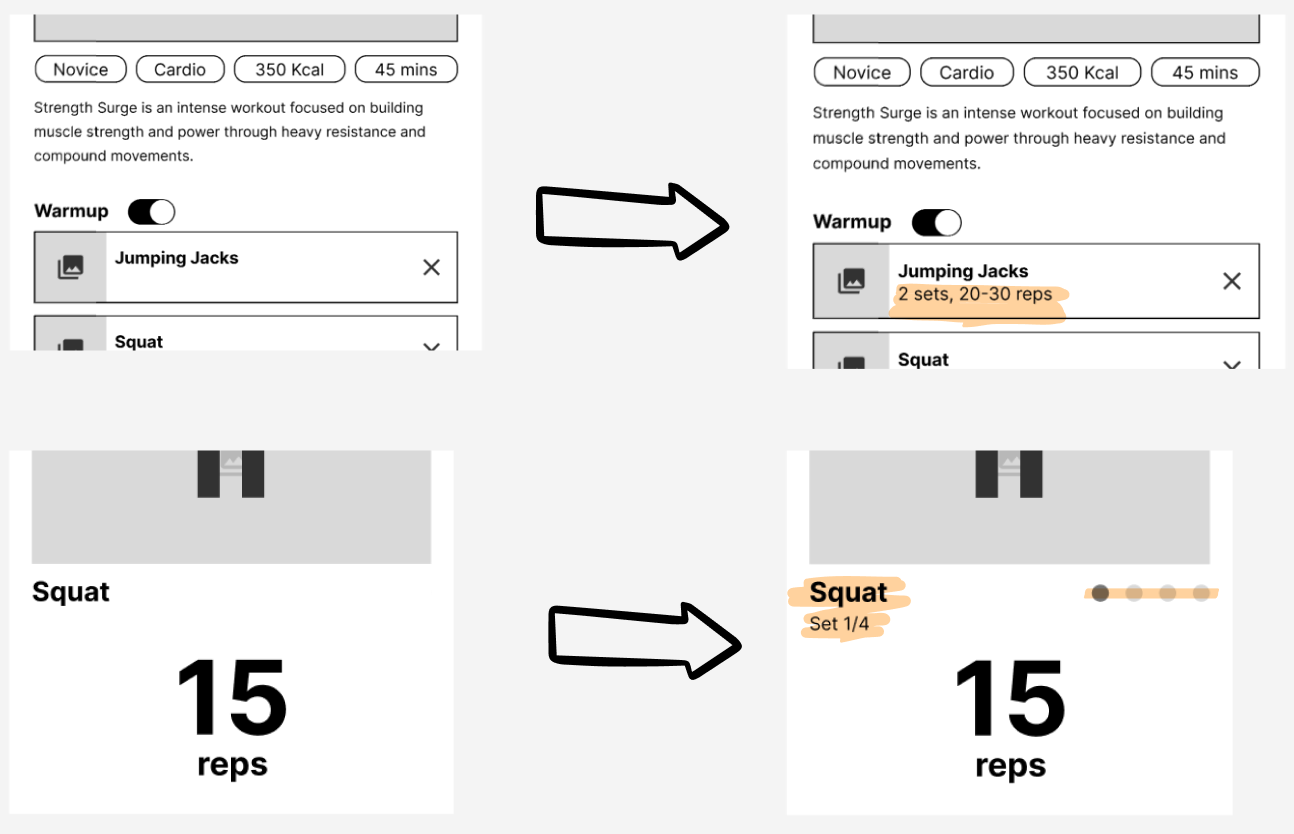
Reflections
Lesson learned
Future improvements
Looking ahead, there are several opportunities to enhance the app and further engage users:
- Statistics: Adding more detailed workout performance metrics and progress tracking will give users a better understanding of their improvement over time.
- Favorite Workouts: A dedicated page where users can save and revisit their preferred workouts, allowing for easy access to the routines they enjoy most.
- Coaches: Developing detailed profiles for trainers, including their expertise, ratings, and personalized recommendations, can help users feel more connected and confident in their workout choices.
- Gamification: Introducing gamified elements like badges, challenges, or leaderboards to motivate and engage users. This would add an extra layer of excitement and accomplishment to their fitness journey.
These future improvements will help refine the user experience, keeping users motivated and engaged as they progress on their fitness journey.